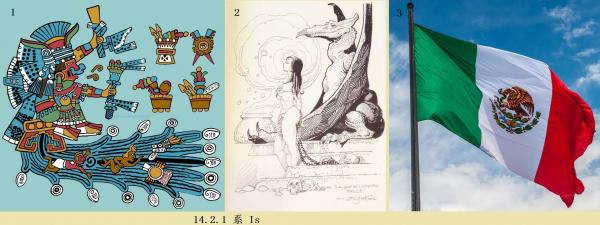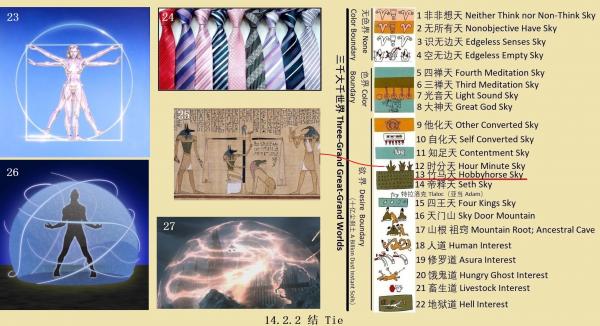| 14.2.0-14.2.6 煩惱的名 Names of Annoyances |
| 送交者: 盧岩 2024年01月11日12:46:35 於 [茗香茶語] 發送悄悄話 |
|
煩惱即糊塗,會令人感覺心緒嘈雜,身心沉重,是拘礙人身心的枷鎖,有很多異名,此說26種:1系,2結,3取,4箭,5隨煩惱,6隨眠,7瀑流,8軛,9縛, 10垢,11常害,12所有,13根,14惡行,15匱,16燒,17惱,18諍,19火,20熾然,21稠林,22拘礙,23漏,24株杌,25蓋,26纏。 Annoyances are muddles, which makes people feel noisy and heavy in body and mind, are fetters that hinder and detain the body and heart. There are many synonyms for them, of which 26 are mentioned here: 1 is, 2 tie, 3 fetch, 4 arrows, 5 latent annoyance, 6 following sleep, 7 cascade, 8 yoke, 9 binding, 10 maculate, 11 constant harm, 12 possessions, 13 root, 14 ferocious behavior, 15 deficient, 16 burn, 17 anger, 18 expostulation, 19 fire, 20 blazing, 21 thick forest, 22 detention, 23 leakage, 24 stump, 25 cover, 26 twine. 14.2.1 系 Is. 系即系表動詞是,系縛義,締結生命義,參見前節的注6。為什麼系是煩惱呢?前節案例說了,通過夏娃識的認可(即是),她和亞當識通力合作,很短的時間內就創造了一個塵剎土世界,包括其中的眾生和事物。夏娃識製造生命很快,像似水流一樣,如圖14.2.1-1是墨西哥的夏娃翠玉女,生命之水(即眾生和意義)從她的裙子上就流出來了。現實生活中此二識日夜創造眾生和事物,而那些都分食 “心識流”,讓人心緒嘈雜,身心沉重。所以夏娃識也被稱作污染識;亞當識包含了許多壞種,過失也很嚴重。古人為了提醒後人系的危害,把生命之樹上的解脫果命名成了離系果(參見11.6.4節《離系果》)。系有四種:1貪慾身系,2瞋恚身系,3此實執取身系,4戒禁取身系。 “IS” is the verb “is”, means tether, tethering life, (see annotation 6 in the previous section). Why is “is” an alias of annoyance? The case of the previous section says that through cognition (i.e., is) of Eve-sense (i.e., preconsciousness), and Adam-sense (i.e., maculate part of unconsciousness) cooperated to create a “dust instant soil world”, including the beings in it, in a very short time. Eve-sense creates lives very quickly, like water flowing, as in Figure 14.2.1-1, which shows the Mexican Eve Chalchiuhtlicue, with the life-water (i.e., sentients and meanings) flowing right out of her dress. In real life these two senses create sentients and things day and night, and which all partake of the senses-stream of heart, make one's heart and body heavy. Therefore, Eve-sense is also called Contamination; Adam-sense contains many bad seeds, so also with serious faults. In order to remind future people of the harms of Is., ancients named the fruit of liberation on Tree of Life the Off-is Fruit (see Section 11.6.4, Off-is Fruit). There are four kinds of is-es: 1 greedy-desire body-is.; 2 irritation-anger body-is.; 3 is-real obsessively-fetch body-is.; 4 precept-taboo-fetch body-is.
一)貪慾身系,由貪愛財物等為因,所貪愛的事物系縛於心,另心變得粗重。貪愛得多了,心意就散亂了;此說,貪慾能障礙綁縛心之自體,另心識流分散。 1) Greedy Desire Body Is. is caused by the craving for possessions, etc., which bind up the body and heart, and make the heart rough and heavy. The heart becomes scattered when there are many greedy desires; this means that greed and desire can bind up self-body of heart and disperse heart-senses stream. 插圖14.2.1-2是《墨西哥法典》中對系煩惱的表述。故事約發生在公元1325年,國王舍利王把王位傳給了自己的教子墨西哥,可他死時墨西哥還流亡在國外,於是他任命自己的女兒卡特莉(即那個階段的翠玉女)為代理國王,等待墨西哥歸來後再把王位傳給他。可是卡特莉很貪婪,想自己當國王,也因此對舍利王和墨西哥很氣憤,所以她想暗殺墨西哥於歸來的途中。 Illustration 14.2.1-2 is a representation of annoyance “is” from Mexican Codex. The story goes that in about 1325 C.E., King Huitzilopochtli passed the throne to his godson, Mexico, but Mexico was still in exile when he died, so Huitzilopochtli instructed his own daughter, Tlaltecuhtli, who was Chalchiuhtlicue at that stage of her life, to be the deputy king and wait for Mexico's return to pass the throne on to him. But Tlaltecuhtli was greedy and wanted to be king herself, and was therefore angry with Huitzilopochtli and Mexico, so she wanted to assassinate Mexico on his way back. 墨西哥發現後,認為卡特莉是她自己 “貪慾和瞋恚” 的囚徒 (如圖2,那怪物是蛇、鱷魚、和鷹的結合體)。據傳說,一天墨西哥看到了墨西哥國旗上的圖案(如圖3),意識到了卡特莉就是圖上的那隻鷹或鳳凰,如果她自己吃掉自己的貪婪,可以勝任眾生之母。圖上的蛇象徵着貪婪,因為蛇吃蛋不吐皮,吞鳥毛不剩。於是把墨西哥(是一位亞當轉世,異名特拉洛克)的王位作為求婚的聘禮送給了卡特莉;翠玉女(是隨後卡特莉;是一位夏娃轉世)就成為了墨西哥帝國的開國皇帝。所以,此二人就成為墨西哥民族的始祖,而舍利王就成為了墨西哥的太陽神。 When Mexico found out, he believed that Tlaltecuhtli was the prisoner of her own "greed and anger" (Figure 2, the monster is a combination of snake, crocodile and eagle). According to legend, one day Mexico saw the picture on the Mexican flag (fig. 3) and realized that Tlaltecuhtli is the eagle or phoenix in the picture, and that she could be competent as the mother of all beings if she ate her own greed. The serpent on the picture symbolizes greed, for a snake eats eggs without spitting out the shells and swallows a bird without leaving feathers. So, Mexico (is an incarnation of Adam; aka. Tlaloc) gave Mexican throne to Tlaltecuhtli as a marriage proposal gift to satiate her; so Chalchiuhtlicue (i.e., later Tlaltecuhtli; is an incarnation of Eve) became the founding emperor of the Mexican Empire. Therefore, the two became the primogenitors of Mexican Nationality, and Huitzilopochtli became Mexican Sun God. 二)瞋恚身系,由諍斗故,眾生多行不正;此不正確的行為能綁縛心之自體,令心散亂。 2) Irritated-Anger Body Is. Due to expostulations and fights, sentients behave incorrectly, which incorrect behaviors can bind the body and heart, and cause the heart to be scattered. 三)此實執取身系,由不如理作意,推求境界妄生執着我見、邊見、邪見、和見取見(參見11.4.4.1.4《根本煩惱》),計唯此真實,余皆愚妄。由此為因,令心散亂。 3) Is-real Obsessive-Fetch Body Is. Due to not according to theories to make intents, reasoning from desirably perused environment, one illusively obsesses to Seth-view (cf. section 11.4.4.1.4 Fundamental Annoyances), edge-view, heresy, or heretical-view, believes which is the only real, the rest are all foolish delusions. Because of this reason, heart is in dispersion. 四)戒禁取身系,對於戒禁不能正卻理解,肆意曲解,旺興執着,由無利勤苦為因,令心散亂。 4) Precept and Taboo Fetch Body Is. Precept-fetch means that to the precepts and prohibitions, one does not understand correctly, indulge in misunderstanding, compassionately obsess to the fetched views from precepts and taboos; due to which bitter of nonbeneficial diligent labours, heart is in dispersion. 14.2.2 結 Tie 據說,這裡談的結(如圖14.2.2-24所示)和後文的蓋頭、帽子、圍巾等都是上帝給亞當和夏娃穿的衣服,稱作心衣。衣服的尺寸就是衣服的功能範圍,如圖23、26、27所示。插圖25源自古埃及壁畫,描述的是時分天正在稱量心重,重一根羽毛可以通過。心是思想意識義,沒有重量;他們實際是在稱量心衣的重量。佛教中稱此心衣的功能範圍為結界。結界就是電影或故事中的神秘場力,本質是隱私空間,防衛心、忌諱、猜疑、恐懼等的勢力,(參見6.6節的案例)。另外,本書11.4.4節《行蘊》中的某些善法也被稱作心衣;16.2節的具足戒,又名黃金甲,金縷衣等。 The ties talked about here (shown in Figure 14.2.2-24) and the covers, hats, scarves, etc., later in the text are said to be the Heart Cloths that God made to Adam and Eve to wear. The sizes of the cloths are the range of cloths’ functions, as shown in Illustrations 23, 26, and 27. Illustration 25 is derived from an ancient Egyptian fresco depicting the Hour-Minute sky were weighing the heart, weighing a feather to pass through. The heart means mind, weightless; they were actually weighing the heart cloths. In Buddhism, the ranges of heart cloths’ functions are called Tie Boundaries. Tie Boundaries are the mystical field force in movies and stories, essentially spaces of privacy, self-defending heart, taboos, suspicions, fears, etc., (see the case in section 6.6). In addition, certain benevolent laws in the book's section 11.4.4 are also known as the heart cloths; and the full precepts of section 16.2, also known as the Golden Armor, invisibility cloak, and so on.
愛結、嗔結、痴結等九結能綁縛人於苦惱的處境,和合眾苦,樹立結界,使人的本心遭到污染、覆蓋和摧殘,從事無利塵勞。結界的界是種子義(參見11.2節),因為眾生依界而生。一切煩惱皆能合苦,愛、恚等九法尤為強烈,故取九結來說明。這九結是:愛結、恚結、無明結、慢結、疑結、見結、取結、嫉結、慳結。 The nine ties of love, irritation, and ignorance, etc. can bind people in afflictive situations, combines crowds of bitterness, and set up Tie Boundaries, which contaminate, conceive, and torture people’s hearts, to have them pursue unbeneficial dust labors. The word boundary of Tie Boundary means Seed (see section 11.2), because sentients depend on boundaries to live, to grow. All annoyances can combine bitter, but love, irritation, etc. nine laws are particularly serious, therefore, the nine ties are used to illustrate. The nine ties are: love tie, vexation tie, non-light tie, view tie, fetch tie, arrogance tie, suspicion tie, jealousy tie, and stingy tie. 一)愛結,以染着為性,是貪的相分(參見11.1節《法的四分》),對於順境中所感樂受,希望能長期持有。一切煩惱皆能合眾苦,就是因為貪愛。眾生為貪愛故,廣行不善,遂招致當來的不平等、不正確、生老病死憂惱之苦,流轉於惑業苦的惡性循環(參見13.4.1 流轉),不能出離。 1) Love Tie, love is by dye, clinging as nature, is greed’s phenomenal quadrant (see section 11.1 Juristic Quadrants), is the desire to hold on to the pleasures in enjoyable environment for a longer time. It is because of greedy love that all annoyances are combining crowds of bitter. Because of greedy love, sentient beings perform a wide range of non-benevolences, which leads to the inequality, incorrectness, bitterness of birth old illness and death, and stuck in the vicious cycle of muddle, karma, and bitterness (see 13.4.1 Cycle), from which they can not be free. 二)恚結,以憤恨為性,對於違境所感苦受,所起不憤的情緒及嗔恚之想。眾生為嗔恚故,廣行不善,遂招致當來的不平等、不正確、生老病死憂惱之苦,流轉於惑業苦三輪(參見13.4.1 流轉),不能出離。 2) Vexation Tie, is by anger and hate as nature, is the acceptances of resentment and the thinkings of irritation and hate. Because of irritation and hate, sentient beings perform a wide range of non-benevolences, which leads to the inequality incorrectness and bitterness of birth old illness death, stuck in the vicious cycle of muddle karma and bitterness (see 13.4.1 Cycle), from which they can not be free. 三)無明結,無明(參見前一小節的注1)即無知、愚痴;即於違順諸境,苦樂諸受,所起的與道理相違愚痴之想。無明結是說眾生心性為無明所覆,於集諦的因法和苦諦的果法不能了解,廣行不善,遂招致當來的不平等、不正確、生老病死憂惱之苦,流轉於惑業苦的循環(參見13.4.1 流轉)之中,不能出離。 3) Non-light Tie, the non-light is the dimness in previous section annotation 1, means ignorance, fool, are irrational foolish thinkings that arise in the midst of either adverse or advantageous etc. environments, bitter or happy etc. acceptances. The non-light tie means that sentient beings' hearts are so conceived by non-light that they are unable to understand the cause laws of chapter 14 Aggregate Crux, and the fruit laws of chapter 13 Bitter Crux, perform a wide range of non-benevolences, which leads to the inequality, incorrectness, bitterness of birth old illness and death, and stuck in the vicious cycle of muddle, karma, and bitterness (see 13.4.1 Cycle), from which they can not be free. 四)見結,謂眾生於我見、邊見、邪見、見取見、戒禁取見(此五惡見參見11.4.4.1.4節),妄興執着,廣行不善,遂招致當來的不平等、不正確、生老病死憂惱之苦,流轉於惑業苦三輪,不能出離。 4) View Tie, saying that sentient beings compassionately obsess I view (i.e., Seth View), edge view, heresy, view fetch, and precept fetch (for the five ferocious views, see section 11.4.4.1.4), perform a wide range of non-benevolences, which leads to the inequality, incorrectness, bitterness of birth old illness and death, and stuck in the vicious cycle of muddle, karma, and bitterness (see 13.4.1 Cycle), from which they can not be free. 五)取結,取即所取和能取;所取者是受,能取者是想。此二取習氣,即受蘊和想蘊(參見11.4.2, 3 節),是世間本。取結是說眾生於所取、能取不能了解,妄意隨順執着此二取習氣,廣行不善,遂招致當來的不平等、不正確、生老病死憂惱之苦,流轉於六道輪迴,不能出離。 5) Fetch Tie, fetch includes the capable to fetch, which is think, and the being fetched, which is acceptance. The two fetch habits are Think Node and Acceptance Node (see section 11.4.2.3). Fetch tie means that sentient beings are unable to understand what is the able to fetch and what is the being fetched, they delusionally yield to the two fetch habits, and perform a wide range of non-benevolences, which leads to the inequality, incorrectness, bitterness of birth old illness and death, and stuck in the vicious cycle of muddle, karma, and bitterness (see 13.4.1 Cycle), from which they can not be free. 六)慢結,謂不懂我法,妄執我及我所而凌駕於它人。慢結是說眾生依仗自己所擅長,於它有情高舉傲慢,廣行不善,遂招致當來的不平等、不正確、生老病死憂惱之苦,流轉於六道輪迴,不能出離。 4) Arrogance Tie, saying that sentient beings do not understand I law (i.e., Seth view), illusively lifting I and mine above others. Arrogance tie means that depending on advantage, one arrogantly lifts oneself over other sentients, and perform a wide range of non-benevolences, which leads to the inequality, incorrectness, bitterness of birth old illness and death, and stuck in the vicious cycle of muddle, karma, and bitterness, from which they can not be free. 七)疑結,謂眾生於四勝諦(參見第11-16章)的人生道理妄生疑惑,不修正行,廣行不善,遂招致當來的不平等、不正確、生老病死憂惱之苦,流轉於惑業苦的循環流轉,不能出離。 7) Suspicion Tie, saying that that sentient beings suspect the life principles of Four Victorious Cruxes (chapter 13 through 16 of the book), do not cultivate correct behaviors, perform a wide range of non-benevolences, which leads to the inequality, incorrectness, bitterness of birth old illness and death, and stuck in the vicious cycle of muddle, karma, and bitterness (see 13.4.1 Cycle), from which they can not be free. 八)嫉結,謂眾生耽着名利,見它榮富,起嫉妒心,廣行不善,遂招致當來的不平等、不正確、生老病死憂惱之苦,流轉於惑業苦三輪,不能出離。 8) Jealousy Tie, saying that sentient beings are obsessed with fame and wealth, become jealous when they see others fame and wealth, so they perform a wide range of non-benevolences, which leads to the inequality, incorrectness, bitterness of birth old illness and death, and stuck in the vicious cycle of muddle, karma, and bitterness, from which they can not be free. 九)慳結,謂眾生耽着名利,於資生具,其心貪吝,不能舍施,廣行不善,遂招致當來的不平等、不正確、生老病死憂惱之苦,流轉於六道輪迴,不能出離。 9) Stingy Tie, saying that sentient beings are obsessed with fame and wealth. Their hearts are greedy and stingy on life assets, unable to donate, so they perform a wide range of non-benevolences, which leads to the inequality, incorrectness, bitterness of birth old illness and death, and stuck in the vicious cycle of muddle, karma, and bitterness, from which they can not be free. 14.2.3 取 Fetch 取義為執取諍根和執取後有;有四種:欲取,我語取,見取,戒禁取。欲取依欲界而建立;後三種依色界和無色界而建立。欲界、色界、和無色界,這三個概念參見第13章苦諦。 Fetch means “obsessively fetch expostulating-root”, and “obsessively fetch later-have”; there are four kinds: desire fetch, I-lingual fetch, view fetch, precept fetch. Desire fetch is established on Desire Boundary; the last three are established on Color Boundary and Colorless Boundary. For the concepts of desire boundary, color boundary, and colorless boundary see chapter 13 Bitter Crux. 一)欲取,謂欲界眾生貪着飲食、睡眠、和性行為等色聲香味觸五欲,為獲得受用,互相鬥諍。這斗諍的根本是五欲取。 1) Desire Fetch, saying that sentient beings crave color sound incense taste and touch, the five kinds of desires, such as food, drink, sleep, and sexual intercourse. In order to enjoy the acceptances of those five dusts, they expostulate and fight with each other. The root cause of these expostulations and fights is the Five Desire Fetches. 二)我語取,謂依我見而取;我語就是口語中的我字,即轉移身見,梵語薩迦耶見,英語塞斯,納瓦特爾語Titlacauan(義為我們是它的奴隸)。。當我見破敗時,世人又妄執六十二種邊見和邪見(參見11.4.4.1.4 根本煩惱)。此三種見就是被執取的諍根。下文的見取和戒禁取是依此諍根而執取後有。 2) I Lingual Fetch, saying that depending on I-view to fetch, “I” is the oral saying of me, I-view means Seth view, Chinese calls “translocation body view”, Sanskrit is sakkāya-diṭṭh, Nahuatl Titlacauan that means we are its slave. When Seth-view is broken, mundane people illusively cling to the 62 Edge-views and Heresies (see section 11.4.4.1.4 Fundamental Annoyances). These three kinds of views are the expostulating roots of being obsessively fetched. The following View Fetch and Precept Fetch are depending on the expostulating roots to obsessively fetch later haves. 三)見取,即根本煩惱惡見中的一百零八種見取見,謂於諸見及所依蘊,執為最勝,認為執彼能得清淨涅槃。 3) View Fetch, that is the 108 kinds of “Views fetched from Views” among the Ferocious Views (see section 11.4.4.1.4.6-4), saying that obsessively holding views and their dependent node as the most victorious, they believe in by doing so, can gain immaculate nirvana. 四)戒禁取,戒條總說為男人的三千威儀八萬四千細行和女人的五百威儀十萬八千魅力(參見16.2節《離垢地》),世人對戒條的某些條款曲解妄執,認為持彼戒禁能得涅槃,如執行性器官割禮,和尚不吃肉等。 4) Views Fetched from Precepts and Taboos, generally to say precepts are, 3,000 Majesties and 84,000 Enchantments for man, and 500 Majesties and 108,000 Charms for woman (see section 16.2). Mundane people have misinterpreted and deluded themself into believing that holding some practises and precepts can gain salvation, such as using tap water to baptise, genital circumcision, and monks not eating meat, etc. 14.2.4 箭 Arrows貪瞋痴三毒能射傷行人,使行人於有果法及三有的因,深起追求,由是生死相續不絕,故立名貪嗔痴為三支箭。 Greed, Irritation, and Ignorance, the three poisons can shoot, injure migrators, causing them to compassionately pursue the “have fruit laws” and the causes of Three Haves, thus, birth and death succeed each other unceasingly, therefore Greed, Irritation, and Ignorance are set up the name of three arrows.
“有果法” 是說有人認為插圖14.2.4-13 至-1的成就有,存在。又由於貪瞋痴是有的組成部分,所以追求“有果法”的人就已經中箭了,就已經被貪嗔痴射傷了,為什麼?因為插圖14.2.4-13及以上都是無為法(參見11.6.4節《離系果》),只與舍和空性相應,與取、集、和得的性質相違。三有就是欲界、色界、和無色界。 “Have Fruit Laws” is saying that some people believe that the accomplishments in Illustrations 14.2.4-13 to 1 have, exist. And because Greed, Irritation, and Ignorance are components of haves, so those who pursue “Have Fruit Laws” are shot, wounded by greed, irritation, and ignorance, wherein? This is because Illustration 14.2.4-13 and above are all Non-as Laws (see section 11.6.4 Off-is Fruit), corresponding only to the nature of renunciation and emptiness, and contrary to the nature of fetch, aggregate, and gain. The three haves are Desire Boundary, Color Boundary, and Colorless Boundary. 插圖14.2.4-24源自古埃及壁畫;圖中埃及夏娃正在展示洗禮的過程。圖2中她的頭頂有兩支箭,表示她那時還有貪和嗔,這兩種思惑。那第三支箭在哪兒?已經被她自己拔除了。當一個人懂得了四勝諦,她或他的痴就已經被消滅了。 Illustration 14.2.4-24 is derived from an ancient Egyptian fresco; it shows the Egyptian Eve demonstrating the process of baptism. There are two arrows above her head in Figure 2, indicating that she still had greed and irritation, the two Mean Muddles, at that time. And where is the third arrow? It has been plucked out by herself. When a person understands the Four Victorious Cruxes, her or his ignorance has been eliminated. 14.2.5 隨煩惱 Latent Annoyances 前面談的貪、嗔、痴、慢、疑、和惡見是六種根本煩惱。本小節談的20位法是根本煩惱的跟隨者,故名隨煩惱,分別是忿、恨、覆、惱、嫉、慳、誑、諂、害、驕、無慚、無愧、掉舉、昏沉、不信、懈怠、放逸、失念、散亂、不正知(參見11.4.4.1.5節的 隨煩惱)。 Previously talked the six fundamental annoyances, namely Greed, Irritation, Ignorance, Arrogance, Suspicion, and Ferocious View. Here, the 20 annoyances are followers, are “equal stream” of the six fundamental annoyances, hence are Latent Annoyances, namely Resentment, Hate, Concealment, Rage, Jealousy, Stinginess, Deceit, Flattery, Harm, Contemptuousness, Shamelessness, Sinlessness, Depression, Drowsiness, Unbelief, Slackness, Indulgence, Loss spell, Agitation, and Incorrect Know (see section 11.4.4.1.5 Latent Annoyances). 14.2.6 隨眠 Following Sleep 隨眠是煩惱種子,即煩惱品所有的勢力,追逐依附在有情身心中,眠伏着,能為種子而生起一切煩惱現行,故立名隨眠。隨眠有七種。 Following Sleep means the seeds of annoyances, i.e., all potential power of annoyances which chase and cling to sentient beings' bodies and hearts to dormant, and they are able to give rise to all the annoyances, therefore the name of Following Sleep was set up. There are seven kinds of Following Sleep.
一)欲愛隨眠,就是欲界貪品煩惱的種子。依未離欲界貪求的眾生,由欲愛之所隨增故,建立欲愛隨眠。品就是下一小節中的81階級。 1) Desir-Love Following-Sleep, that are the seeds of all grades’ greed in desire boundary. To sentient beings who are not free from the greed and chase in desire boundary, their desires and loves are escalating, so the Following Sleep of Desire and Love is established. Grades means the 81 grades in section 14.3. 二)瞋恚隨眠,就是欲界瞋品煩惱的種子。依未離欲界貪求的眾生,由瞋恚之所隨增故,建立瞋恚隨眠。 2) Irritation-Anger Following-Sleep are the seeds of all grades’ irritations in desire boundary. To sentient beings have not left the greedily chases in desire boundary, since their irritations and angers are escalating, the Following-Sleep of Irritation-Anger is established. 三)有愛隨眠,就是色界無色界貪品煩惱的種子。依未離邪染而求神行的眾生,由有貪嗔痴業而建立有愛隨眠。此說,自無始以來,有與貪嗔痴伴生,一切有之中都有貪嗔痴的成分。 3) Have-Loves Following-Sleeps, that are the seeds of all grades’ greed in color boundary and colorless boundary. To sentient beings who have not left heretical contaminations and who are pursuing Godly migration, since their karmas of greed, irritation, and ignorance, the Following-Sleeps of Have-Loves are established. This says that since the beginning of time, greed, irritation, and ignorance are concomitants with have, therefore there are greed, irritation, and ignorance in all haves, in everything. 四)慢隨眠,就是慢品煩惱種子。即由彼眾生學習了一些佛法,心中便起憍慢,故立慢隨眠。 4) Arrogance Following-Sleeps are the seeds of all grades’ arrogance. There are kinds of sentient beings who start to bosom arrogance after learned some Buddhism, therefore, the Following-Sleeps of Arrogance are set up. 五)無明隨眠,就是無明煩惱品的種子。依對四勝諦的因果理愚迷不知的眾生,由於順境、逆境、平等境(即中性境)中起顛倒妄想,立無明隨眠。 5) Non-light Following-Sleeps are the seeds of non-light annoyances. To sentient beings who are ignorant of the of causes and effects in Four Victorious Cruxes, they arouse upside-down illusive thinkings among enjoyable, neutral, and adverse environments, therefore, the Following-Sleeps of Non-light are set up. 六)見隨眠,就是見品煩惱的種子,就是後文中的112位見煩惱的根,根深蒂固,難解難消。 6) View Following-Sleep, which are the seeds of all grades’ view muddles, are the roots of the 112 View Muddles in the later text. Those roots are deep and solid, difficult to dissolve and eliminate. 七)疑隨眠,就是疑品煩惱的種子。由眾生對此四勝諦正法猶豫疑惑,如其次第立慢、無明、見、疑隨眠。 (7) Suspicion Following-Sleeps are the seeds of all grades’ doubts. Sentient beings are irresolute to the four victorious cruxes, therefore, according to their sequence, the Following-Sleeps of Arrogance, Non-light, View, and Suspicion are established. ↪️返回第十三章《集諦》目錄↪️Back to Catalog of Chapter 13 Aggregate Crux |
|
|
|
|
 |
 |
| 實用資訊 | |
|
|
|
|
| 一周點擊熱帖 | 更多>> |
|
|
|
| 一周回復熱帖 |
|
|
|
|
| 歷史上的今天:回復熱帖 |
| 2023: | 我早就告訴過你們生化科學家都是騙子。 | |
| 2023: | 這隻貓媽媽的修養真的不錯 | |
| 2022: | ZT:達拉斯第一浸信會華人團契的開始 | |
| 2022: | 水費漲價20%,天燃氣漲30%,房地產稅漲 | |
| 2021: | 昨天的新聞說推特掉了7%,今天又掉了12 | |
| 2021: | 自戀狂老穿永遠也不會想明白自己為何輸 | |
| 2020: | 發現文學城好看多了啊,看這篇北京妞逛 | |
| 2020: | 羊城隨記 - 食有魚 | |
| 2019: | 華為高管在波蘭涉間諜罪被捕 | |
| 2019: | xpt 華為宣誓,近平宣誓,中國人宣誓 | |







